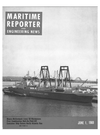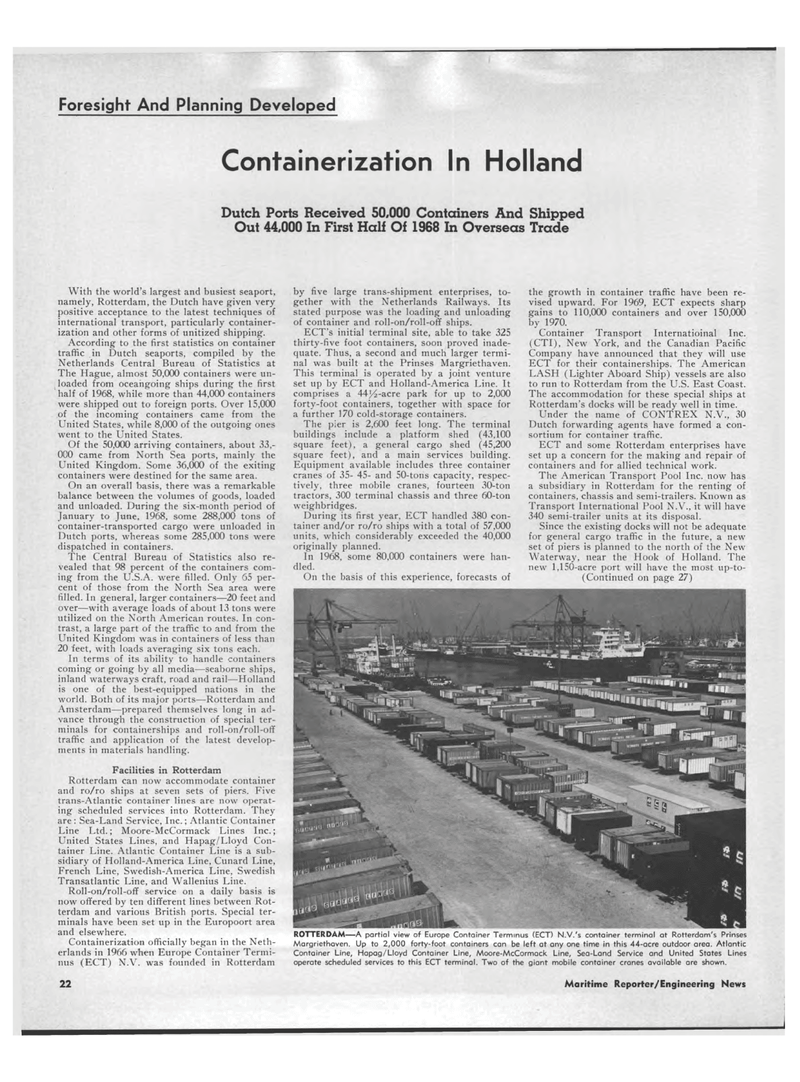
Page 20: of Marine News Magazine (June 1969)
Read this page in Pdf, Flash or Html5 edition of June 1969 Marine News Magazine
Foresight And Planning Developed Containerization In Holland Dutch Ports Received 50,000 Containers And Shipped Out 44,000 In First Half Of 1968 In Overseas Trade With the world's largest and busiest seaport, namely, Rotterdam, the Dutch have given very positive acceptance to the latest techniques of international transport, particularly container-ization and other forms of unitized shipping. According to the first statistics on container traffic in Dutch seaports, compiled by the Netherlands Central Bureau of Statistics at The Hague, almost 50,000 containers were un-loaded from oceangoing ships during the first half of 1968, while more than 44,000 containers were shipped out to foreign ports. Over 15,000 of the incoming containers came from the United States, while 8,000 of the outgoing ones went to the United States. Of the 50,000 arriving containers, about 33,-000 came from North Sea ports, mainly the United Kingdom. Some 36,000 of the exiting containers were destined for the same area. On an overall basis, there was a remarkable balance between the volumes of goods, loaded and unloaded. During the six-month period of January to June, 1968, some 288,000 tons of container-transported cargo were unloaded in Dutch ports, whereas some 285,000 tons were dispatched in containers. The Central Bureau of Statistics also re-vealed that 98 percent of the containers com-ing from the U.S.A. were filled. Only 65 per-cent of those from the North Sea area were filled. In general, larger containers?20 feet and over?with average loads of about 13 tons were utilized on the North American routes. In con-trast, a large part of the traffic to and from the United Kingdom was in containers of less than 20 feet, with loads averaging six tons each. In terms of its ability to handle containers coming or going by all media?seaborne ships, inland waterways craft, road and rail?Holland is one of the best-equipped nations in the world. Both of its major ports?Rotterdam and Amsterdam?prepared themselves long in ad-vance through the construction of special ter-minals for containerships and roll-on/roll-off traffic and application of the latest develop-ments in materials handling. Facilities in Rotterdam Rotterdam can now accommodate container and ro/ro ships at seven sets of piers. Five trans-Atlantic container lines are now operat-ing scheduled services into Rotterdam. They are : Sea-Land Service, Inc.; Atlantic Container Line Ltd.; Moore-McCormack Lines Inc.; United States Lines, and Hapag,/Lloyd Con-tainer Line. Atlantic Container Line is a sub-sidiary of Holland-America Line, Cunard Line, French Line, Swedish-America Line, Swedish Transatlantic Line, and Wallenius Line. Roll-on/roll-off service on a daily basis is now offered by ten different lines between Rot-terdam and various British ports. Special ter-minals have been set up in the Europoort area and elsewhere. Containerization officially began in the Neth-erlands in 1966 when Europe Container Termi-nus (ECT) N.V. was founded in Rotterdam by five large trans-shipment enterprises, to-gether with the Netherlands Railways. Its stated purpose was the loading and unloading of container and roll-on/roll-off ships. ECT's initial terminal site, able to take 325 thirty-five foot containers, soon proved inade-quate. Thus, a second and much larger termi-nal was built at the Prinses Margriethaven. This terminal is operated by a joint venture set up by ECT and Holland-America Line. It comprises a 44j^-acre park for up to 2,000 forty-foot containers, together with space for a further 170 cold-storage containers. The pier is 2,600 feet long. The terminal buildings include a platform shed (43,100 square feet), a general cargo shed (45,200 square feet), and a main services building. Equipment available includes three container cranes of 35- 45- and 50-tons capacity, respec-tively, three mobile cranes, fourteen 30-ton tractors, 300 terminal chassis and three 60-ton weighbridges. During its first year, ECT handled 380 con-tainer and/or ro/ro ships with a total of 57,000 units, which considerably exceeded the 40,000 originally planned. In 1968, some 80,000 containers were han-dled. On the basis of this experience, forecasts of the growth in container traffic have been re-vised upward. For 1969, ECT expects sharp gains to 110,000 containers and over 150,000 by 1970. Container Transport Internatioinal Inc. (CTI), New York, and the Canadian Pacific Company have announced that they will use ECT for their containerships. The American LASH (Lighter Aboard Ship) vessels are also to run to Rotterdam from the U.S. East Coast. The accommodation for these special ships at Rotterdam's docks will be ready well in time. Under the name of CONTREX N.V., 30 Dutch forwarding agents have formed a con-sortium for container traffic. ECT and some Rotterdam enterprises have set up a concern for the making and repair of containers and for allied technical work. The American Transport Pool Inc. now has a subsidiary in Rotterdam for the renting of containers, chassis and semi-trailers. Known as Transport International Pool N.V., it will have 340 semi-trailer units at its disposal. Since the existing docks will not be adequate for general cargo traffic in the future, a new set of piers is planned to the north of the New Waterway, near the Hook of Holland. The new 1,150-acre port will have the most up-to-(Continued on page 27) ROTTERDAM?A partial view of Europe Container Terminus (ECT) N.V.'s container terminal at Rotterdam's Prinses Margriethaven. Up to 2,000 forty-foot containers can be left at any one time in this 44-acre outdoor area. Atlantic Container Line, Hapag/Lloyd Container Line, Moore-McCormack Line, Sea-Land Service and United States Lines operate scheduled services to this ECT terminal. Two of the giant mobile container cranes available are shown. 22 Maritime Reporter/Engineering News

 19
19

 21
21
